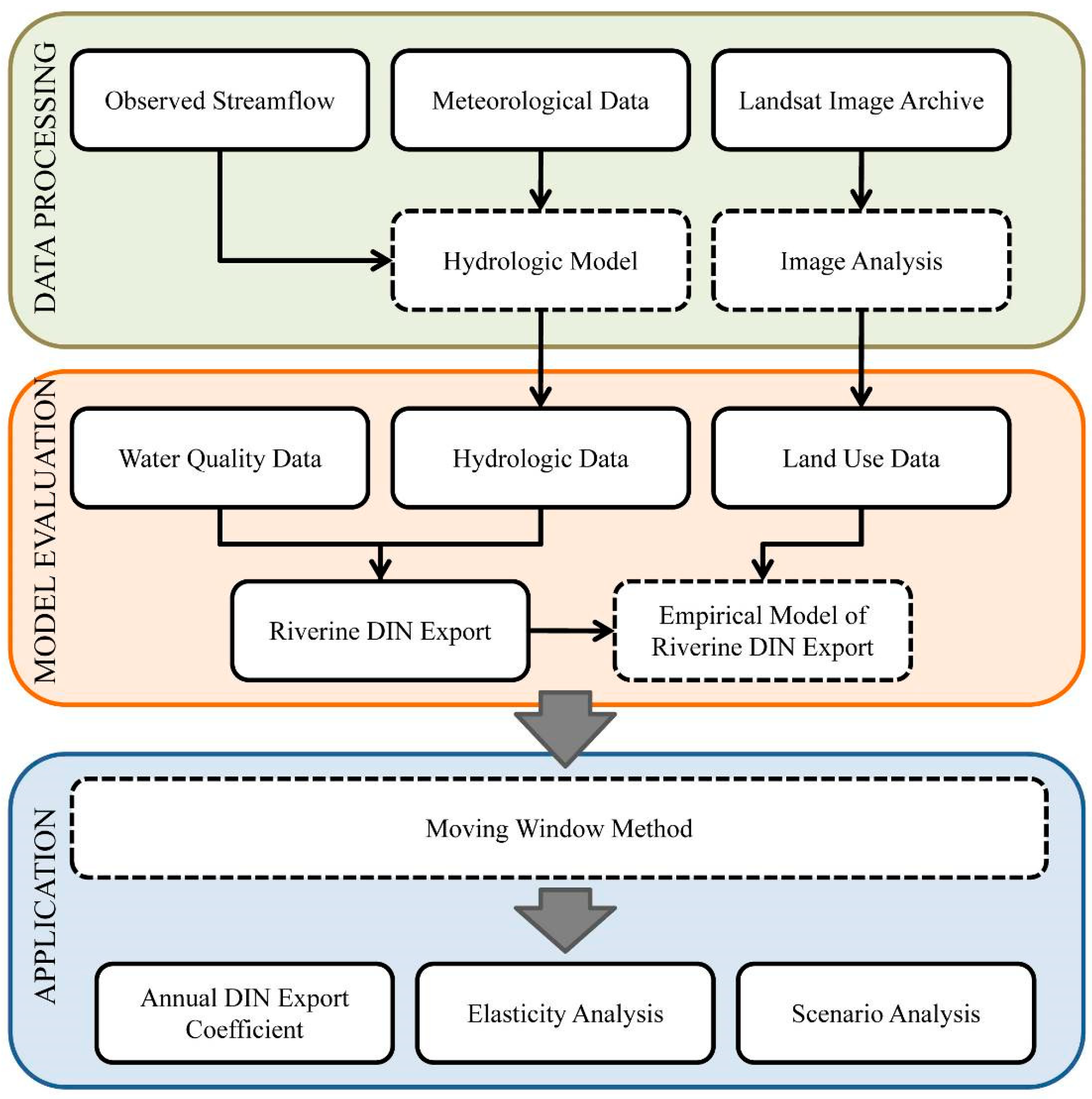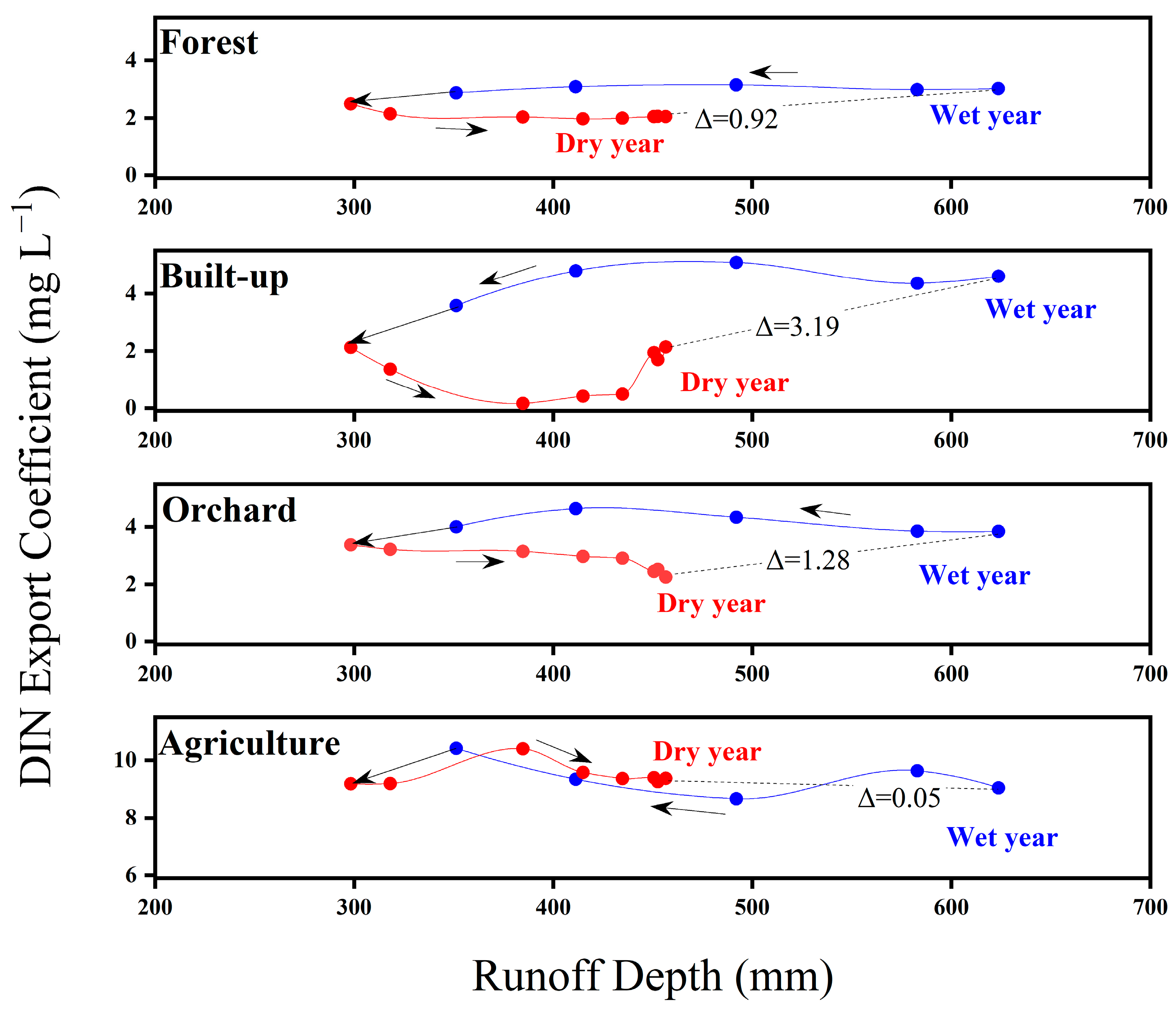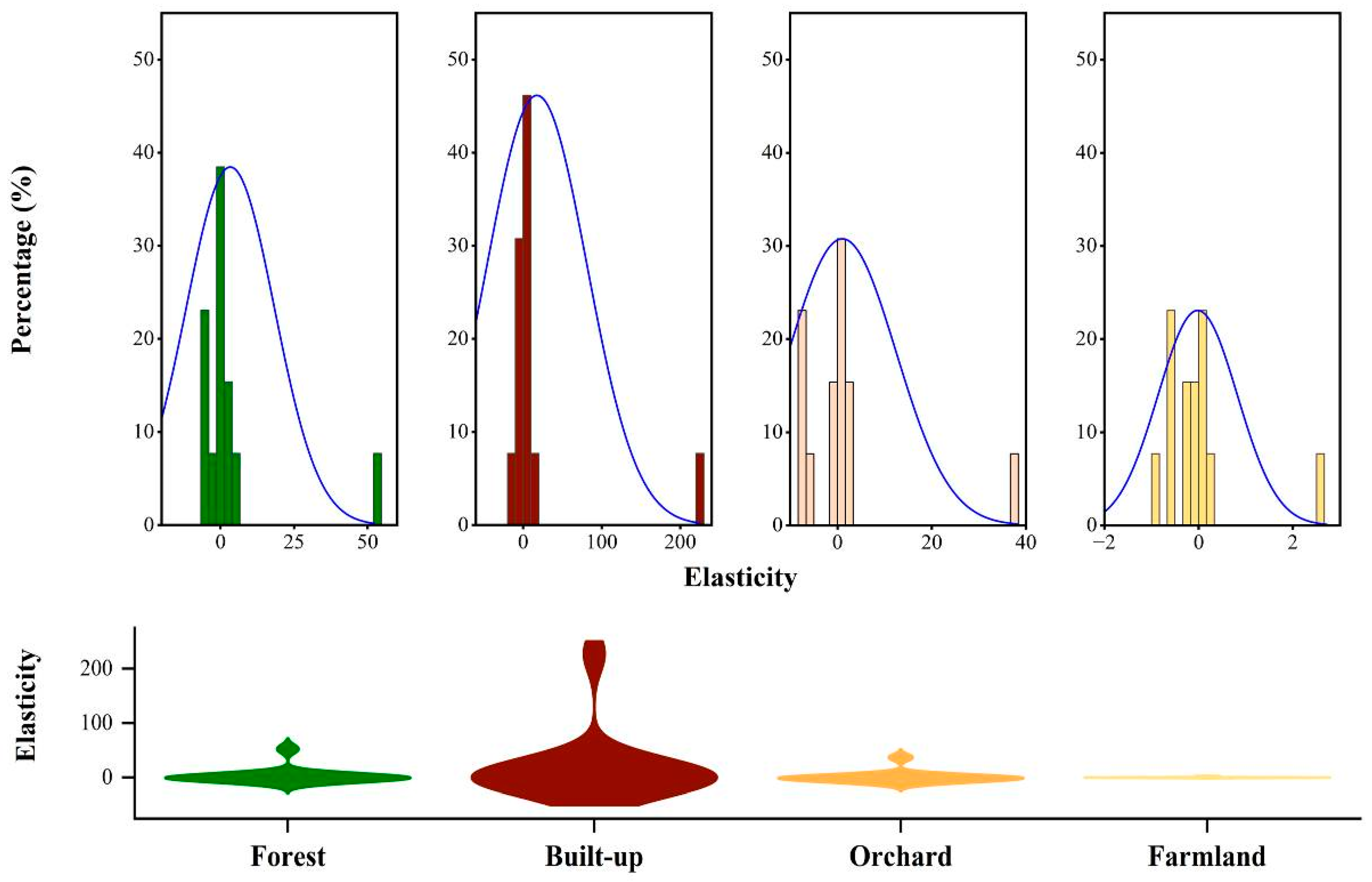A Framework to Quantify Riverine Dissolved Inorganic Nitrogen Exports under Changing Land-Use Patterns and Hydrologic Regimes
Abstract
:1. Introduction
2. Material and Methods
2.1. Study Area
2.2. Analytical Framework
2.2.1. Data Processing
2.2.2. Model Evaluation
2.2.3. Model Application
3. Results
3.1. Linkage between Land Use and DIN Export Using Empirical Model
3.2. Impact of Hydrologic Regime on DIN Export
3.3. Pollution Control Scenario Analysis
4. Discussion
4.1. DIN Export Associated with Mosaic Land-Use Patterns
4.2. Interactive Impact of Land Use and Hydrologic Regime on Riverine DIN Export
4.3. Applicability and Implications
4.4. Limitations and Potential Options for Improvements
5. Conclusions
Supplementary Materials
Author Contributions
Funding
Data Availability Statement
Acknowledgments
Conflicts of Interest
References
- Lu, M.-C.; Chang, C.-T.; Lin, T.-C.; Wang, L.-J.; Wang, C.-P.; Hsu, T.-C.; Huang, J.-C. Modeling the terrestrial N processes in a small mountain catchment through INCA-N: A case study in Taiwan. Sci. Total Environ. 2017, 593–594, 319–329. [Google Scholar] [CrossRef] [PubMed]
- Begstrom, A. The use of TN:TP and DIN:TP ratios as indicators for phytoplankton nutrient limitation in oligotrophic lakes affected by N deposition. Aquat. Sci. 2010, 72, 277–281. [Google Scholar] [CrossRef]
- Peterson, B.J.; Wollheim, W.M.; Mulholland, P.J.; Webster, J.R.; Meyer, J.L.; Tank, J.L.; Marti, E.; Bowden, W.B.; Valett, H.M.; Hershey, A.E.; et al. Control of nitrogen export from watersheds by headwater streams. Science 2001, 292, 86–90. [Google Scholar] [CrossRef]
- Chen, Y.; Cheng, W.; Zhang, H.; Qiao, J.; Liu, J.; Shi, Z.; Gong, W. Evaluation of the total maximum allocated load of dissolved inorganic nitrogen using a watershed–coastal ocean coupled model. Sci. Total Environ. 2019, 673, 734–749. [Google Scholar] [CrossRef] [PubMed]
- Kaushal, S.S.; Mayer, P.M.; Vidon, P.G.; Smith, R.M.; Pennino, M.J.; Newcomer, T.A.; Duan, S.; Welty, C.; Belt, K.T. Land use and climate variability amplify carbon, nutrient, and contaminant pulses: A review with management implications. JAWRA J. Am. Water Resour. Assoc. 2014, 50, 585–614. [Google Scholar] [CrossRef]
- Shih, Y.-T.; Lee, T.-Y.; Huang, J.-C.; Kao, S.-J. Chang Apportioning riverine DIN load to export coefficients of land uses in an urbanized watershed. Sci. Total Environ. 2016, 560–561, 1–11. [Google Scholar] [CrossRef]
- Akhtar, N.; Ishak, M.; Bhawani, S.A.; Umar, K. Various Natural and anthropogenic factors responsible for water quality degradtation: A review. Water 2021, 13, 2660. [Google Scholar] [CrossRef]
- Kamari, M.; Huttunen, I.; Valkama, P.; Huttunen, M.; Korppoo, M.; Tattari, S.; Lotsari, E. Modelling inter- and intra-annual variation of riverine nitrogen/nitrate losses from snowelt-affected basins under agricultural and mixed land use captured with high frequency monitoring. Catena 2019, 176, 227–244. [Google Scholar] [CrossRef]
- Huang, J.-C.; Lee, T.-Y.; Lin, T.-C.; Hein, T.; Lee, L.-C.; Shih, Y.-T.; Kao, S.-J.; Shiah, F.-K.; Lin, N.-H. Effects of different N sources on riverine DIN export and retention in a subtropical high-standing island, Taiwan. Biogeosciences 2016, 13, 1787–1800. [Google Scholar] [CrossRef]
- Zhang, Z.; Montas, H.; Shirmohammadi, A.; Leisnham, P.T.; Negahban-Azar, M. Impacts of land cover change on the spatial distribution of nonpoint source pollution based on SWAT model. Water 2023, 15, 1174. [Google Scholar] [CrossRef]
- Zhang, Z.; Huang, J.; Zhou, M.; Huang, Y.; Lu, Y. A Coupled modeling approach for water management in a river–reservoir system. Int. J. Environ. Res. Public Health 2019, 16, 2949. [Google Scholar] [CrossRef]
- Mander, U.; Kull, A.; Kuusements, V.; Toomas, T. Nutrient runoff dynamics in a rural catchment: Influence of land use changes, climatic fluctuations and ecotechnological measures. Ecol. Eng. 2000, 14, 405–417. [Google Scholar] [CrossRef]
- Pärn, J.; Henine, H.; Kasak, K.; Kauer, K.; Sohar, K.; Tournebize, J.; Uuemaa, E.; Välik, K.; Mander, U. Nitrogen and phosphorus discharge from small agricultural catchments predicted from land use and hydroclimate. Land Use Policy 2018, 75, 260–268. [Google Scholar] [CrossRef]
- Huang, J.-C.; Lee, T.-Y.; Kao, S.-J.; Hsu, S.-C.; Lin, H.-J.; Peng, T.-R. Land use effect and hydrological control on nitrate yield in subtropical mountainous watersheds. Hydrol. Earth Syst. Sci. 2012, 16, 699–714. [Google Scholar] [CrossRef]
- Lee, M.; Shevliakova, E.; Malyshev, S.; Milly, P.C.D.; Jaffé, P.R. Climate variability and extremes, interacting with nitrogen storage, amplify eutrophication risk. Geophys. Res. Lett. 2016, 43, 7520–7528. [Google Scholar] [CrossRef]
- Zhou, Y.; Xu, J.; Yin, W.; Ai, L.; Fang, N.; Tan, W.; Yan, F.; Shi, Z. Hydrological and environmental controls of the stream nitrate concentration and flux in a small agricultural watershed. J. Hydrol. 2017, 545, 355–366. [Google Scholar] [CrossRef]
- De Girolamo, A.M.; Spanò, M.; D’ambrosio, E.; Ricci, G.F.; Gentile, F. Developing a nitrogen load apportionment tool: Theory and application. Agric. Water Manag. 2019, 226, 105806. [Google Scholar] [CrossRef]
- Tzoraki, O.A.; Dörflinger, G.; Kathijotes, N.; Kontou, A. Nutrient-based ecological consideration of a temporary river catchment affected by a reservoir operation to facilitate efficient management. Water Sci. Technol. 2013, 69, 847–854. [Google Scholar] [CrossRef] [PubMed]
- Tomer, M.D.; Meek, D.W.; Jaynes, D.B.; Hatfield, J.L. Evaluation of nitrate-nitrogen fluxes from a tile-drained watershed in central Iowa. J. Environ. Qual. 2003, 32, 642–653. [Google Scholar] [PubMed]
- Zhang, Y.-K.; Schilling, K. Temporal variations and scaling of streamflow and baseflow and their nitrate-nitrogen concentrations and loads. Adv. Water Resour. 2005, 28, 701–710. [Google Scholar] [CrossRef]
- Greaver, T.L.; Clark, C.M.; Compton, J.E.; Vallano, D.; Talhelm, A.F.; Weaver, C.P.; Band, L.E.; Barson, J.S.; Davidson, E.A.; Tague, C.I.; et al. Key ecoligcal responses to nitrogen are altered by climate change. Nat. Clim. Chang. 2016, 6, 836–843. [Google Scholar] [CrossRef]
- Li, W.; Liu, H.; Zhai, L.; Yen, H.; Hu, W.; Lei, Q.; Stewart, R.J.; Guo, S.; Ren, T. Evaluation of concentration-discharge dynamics and nitrogen export on anthropogenic inputs and stormflow across alternative time-scales. Ecol. Indic. 2019, 98, 879–887. [Google Scholar] [CrossRef]
- Huang, Y.; Huang, J.; Ervinia, A.; Duan, S.; Kaushal, S.S. Land use and climate variability amplifies watershed nitrogen exports in coastal China. Ocean Coast. Manag. 2018, 207, 104428. [Google Scholar] [CrossRef]
- Delkash, M.; Furat, A.M.; AI-Faraj Scholz, M. Impacts of anthropogenic land use changes on nutrient concentration in surface waterbodies: A review. Clean Soil Air Water 2018, 46, 1800051. [Google Scholar] [CrossRef]
- Zhang, Z.Y.; Huang, J.L.; Xiao, C.R.; Huang, J.C. Simulation-based method to develop strategies for nitrogen pollution control in a creek watershed with sparse data. Environ. Sci. Pollut. Res. 2020, 27, 38849–38860. [Google Scholar] [CrossRef]
- Lin, F.; Chen, X.; Yao, H.; Lin, F. SWAT model-based quantification of the impact of land-use change on forest-regulated water flow. Catena 2022, 2011, 105975. [Google Scholar] [CrossRef]
- Jackson-Blake, L.A.; Sample, J.E.; Wade, A.J.; Helliwell, R.C.; Skeffington, R.A. Are our dynamic water quality models too complex? A comparison of a new parsimonious phosphorus model, SimplyP, and INCA-P. Water Resour. Res. 2017, 53, 5382–5399. [Google Scholar] [CrossRef]
- Fenicia, F.; Kavetski, D.; Savenije, H.H.G. Elements of a flexible approach for conceptual hydrological modeling: 1. Motivation and theoretical development. Water Resour. Res. 2011, 47, W11510. [Google Scholar] [CrossRef]
- Ferguson, R.I. Accuracy and precision of methods for estimating river loads. Earth Surf. Process. Landforms 1987, 12, 95–104. [Google Scholar] [CrossRef]
- Preston, S.D.; Bierman, V.J.; Silliman, S.E. An evaluation of methods for the estimation of tributary mass loads. Water Resour. Res. 1989, 25, 1379–1389. [Google Scholar] [CrossRef]
- US EPA. User’s Manual of PLOAD Version 3.0: An Arcview GIS Tool to Calcuate Nonpoint Sources of Pollution in Watershed and Storm Water Projects; US EPA: Washington, DC, USA, 2001.
- Gikas, G.D. Water quality of drainage canals and assessment of nutrient loads using QUAL2Kw. Environ. Process. 2014, 1, 369–385. [Google Scholar] [CrossRef]
- Moriasi, D.N.; Arnold, J.G.; van Liew, M.W.; Bingner, R.L.; Harmel, R.D.; Veith, T.L. Model evaluation guidelines for systematic quantification of accuracy in watershed simulations. Trans. ASABE 2007, 50, 885–900. [Google Scholar] [CrossRef]
- Wu, J.; Zeng, S.; Yang, L.; Ren, Y.; Xia, J. Spatiotemporal characteristics of the water quality and its multiscale relationship with land use in the Yangtze River Basin. Remote Sens. 2021, 13, 3309. [Google Scholar] [CrossRef]
- Gall, W.; Duftschmid, G.; Dorda, W. Moving time window aggregates over patient histories. Int. J. Med. Inform. 2001, 63, 133–145. [Google Scholar] [CrossRef] [PubMed]
- Choi, H.T.; Beven, K. Multi-period and multi-criteria model conditioning to reduce prediction uncertainty in an application of TOPMODEL within the GLUE framework. J. Hydrol. 2007, 332, 316–336. [Google Scholar] [CrossRef]
- Sankarasubramanian, A.; Vogel, R.M.; Limbrunner, J.F. Climate elasticity of streamflow in the United States. Water Resour. Res. 2001, 37, 1771–1781. [Google Scholar] [CrossRef]
- Jiang, J.; Sharma, A.; Sivakumar, B.; Wang, P. A global assessment of climate–water quality relationships in large rivers: An elasticity perspective. Sci. Total Environ. 2014, 468–469, 877–891. [Google Scholar] [CrossRef]
- Shields, C.A.; Band, L.E.; Law, N.; Groffman, P.M.; Kaushal, S.S.; Savvas, K.; Fisher, G.T.; Belt, K.T. Streamflow distribution of non-point source nitrogen export from urban-rural catchments in the Chesapeake Bay watershed. Water Resour. Res. 2008, 44, W09416. [Google Scholar] [CrossRef]
- Billy, C.; Birgand, F.; Ansart, P.; Peschard, J.; Sebilo, M.; Tournebize, J. Factors controlling nitrate concentrations in surface waters of an artificially drained agricultural watershed. Landsc. Ecol. 2013, 28, 665–684. [Google Scholar] [CrossRef]
- Zhang, Q.; Wang, Q.; Xu, L.; Zhu, J.; He, N. Monthly dynamics of atmospheric wet nitrogen deposition on different spatial scales in China. Environ. Sci. Pollut. Res. 2018, 25, 24417–24425. [Google Scholar] [CrossRef]
- Zhu, J.; He, N.; Wang, Q.; Yuan, G.; Wen, D.; Yu, G.; Jia, Y. The composition, spatial patterns, and influencing factors of atmospheric wet nitrogen deposition in Chinese terrestrial ecosystems. Sci. Total Environ. 2015, 511, 777–785. [Google Scholar] [CrossRef] [PubMed]
- Gallo, E.L.; Meixner, T.; Aoubid, H.; Lohse, K.A.; Brooks, P.D. Combined impact of catchment size, land cover, and precipitation on streamflow and total dissolved nitrogen: A global comparative analysis. Glob. Biogeochem. Cycles 2015, 29, 1109–1121. [Google Scholar] [CrossRef]
- Simsek, H.; Kasi, M.; Wadhawan, T.; Bye, C.; Blonigen, M.; Khan, E. Fate of dissolved organic nitrogen in two stage trickling filter process. Water Res. 2012, 46, 5115–5126. [Google Scholar] [CrossRef] [PubMed]







| Site ID | Landscape Attributes | Land-Use Composition | ||||
|---|---|---|---|---|---|---|
| Area | Length | Forest | Built-Up | Orchard | Farmland | |
| (Km2) | (m) | (%) | (%) | (%) | (%) | |
| S1 | 1.85 | 1046 | 61.64 | 14.05 | 6.22 | 14.87 |
| S2 | 4.87 | 1734 | 72.01 | 5.89 | 7.16 | 13.49 |
| S3 | 7.92 | 4313 | 66.92 | 8.62 | 8.56 | 12.76 |
| S4 | 8.05 | 5043 | 65.72 | 8.68 | 10.21 | 11.80 |
| S5 | 2.51 | 1756 | 60.17 | 2.12 | 24.70 | 9.94 |
| S6 | 12.73 | 8331 | 56.79 | 7.78 | 20.15 | 11.54 |
| S7 | 14.97 | 9899 | 53.05 | 8.16 | 22.34 | 12.31 |
| S8 | 16.14 | 10,055 | 50.86 | 8.90 | 23.06 | 12.83 |
| S9 | 3.53 | 2891 | 39.34 | 9.93 | 37.23 | 7.67 |
| S10 | 20.98 | 13,100 | 46.28 | 9.86 | 26.75 | 12.23 |
| S11 | 21.19 | 13,465 | 45.84 | 10.13 | 26.74 | 12.36 |
| S12 | 1.4 | 860 | 14.40 | 25.54 | 29.90 | 23.59 |
| S13 | 24.13 | 15,572 | 43.01 | 11.64 | 26.92 | 13.22 |
| S14 | 26.67 | 16,111 | 42.57 | 11.98 | 27.09 | 13.19 |
| S15 | 27.32 | 16,921 | 42.23 | 12.24 | 27.34 | 13.09 |
| S16 | 33.65 | 18,662 | 46.05 | 10.70 | 26.61 | 12.32 |
| Forest (mg L−1) | Built-Up (mg L−1) | Orchard (mg L−1) | Farmland (mg L−1) |
|---|---|---|---|
| 2.91 | 3.91 | 3.70 | 9.16 |
| Calibration | Validation | ||
|---|---|---|---|
| PBIAS | NOF | PBIAS | NOF |
| −0.4 | 0.15 | −22.4 | 0.44 |
Disclaimer/Publisher’s Note: The statements, opinions and data contained in all publications are solely those of the individual author(s) and contributor(s) and not of MDPI and/or the editor(s). MDPI and/or the editor(s) disclaim responsibility for any injury to people or property resulting from any ideas, methods, instructions or products referred to in the content. |
© 2023 by the authors. Licensee MDPI, Basel, Switzerland. This article is an open access article distributed under the terms and conditions of the Creative Commons Attribution (CC BY) license (https://creativecommons.org/licenses/by/4.0/).
Share and Cite
Zhang, Z.; Liao, Y.; Huang, J. A Framework to Quantify Riverine Dissolved Inorganic Nitrogen Exports under Changing Land-Use Patterns and Hydrologic Regimes. Water 2023, 15, 3528. https://doi.org/10.3390/w15203528
Zhang Z, Liao Y, Huang J. A Framework to Quantify Riverine Dissolved Inorganic Nitrogen Exports under Changing Land-Use Patterns and Hydrologic Regimes. Water. 2023; 15(20):3528. https://doi.org/10.3390/w15203528
Chicago/Turabian StyleZhang, Zhenyu, Yajing Liao, and Jinliang Huang. 2023. "A Framework to Quantify Riverine Dissolved Inorganic Nitrogen Exports under Changing Land-Use Patterns and Hydrologic Regimes" Water 15, no. 20: 3528. https://doi.org/10.3390/w15203528
APA StyleZhang, Z., Liao, Y., & Huang, J. (2023). A Framework to Quantify Riverine Dissolved Inorganic Nitrogen Exports under Changing Land-Use Patterns and Hydrologic Regimes. Water, 15(20), 3528. https://doi.org/10.3390/w15203528






